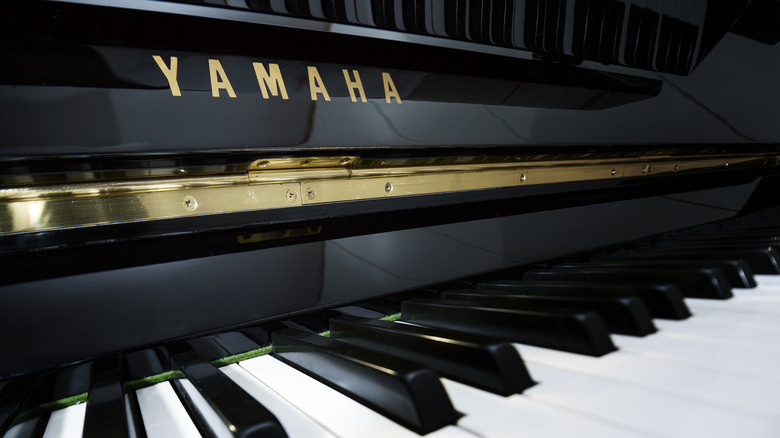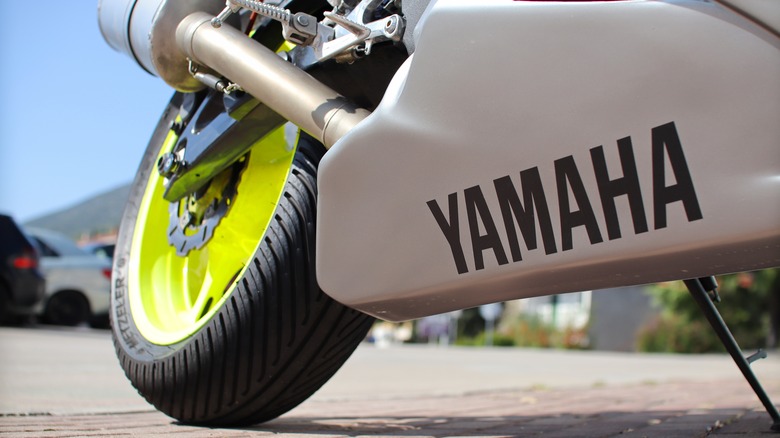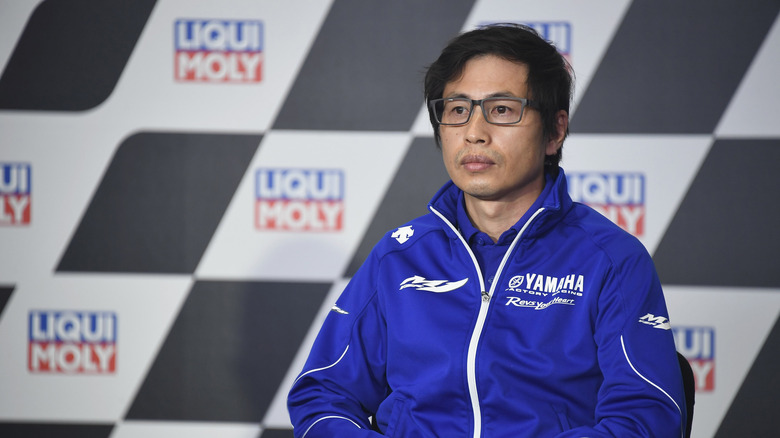
Robertomm/Getty Images
These days, the Yamaha branding is probably most closely associated with Yamaha Motor Co., a leading maker of everything from e-bikes, motorcycles, scooters, golf carts, and ATVs to boats, WaveRunners, and snowmobiles. If it’s a motor vehicle that’s not a car, Yamaha probably makes some version of it. With a reputation for high quality, it’s long been a popular brand and has stood the test of time. But while that’s the most visible use of the Yamaha name, logo, and branding, it’s not the only one.
Yamaha branding is also visible on products from the legacy Yamaha Corporation. This spinoff deals in anything with a motor that can move you around and isn’t a car — the company makes musical instruments (both analog and digital), all sorts of professional audio equipment, headphones, AV receivers, vinyl turntables, speakers, soundbars, and more. In other words, it deals in all facets of sound and sound reproduction, all with a similar reputation for high quality like Yamaha Motor. Among these categories, the brand is probably most visible via Yamaha-branded receivers, speakers, and soundbars that serve as the heart of many home theater systems found in major retail stores.
At one point, these two very different sets of products were all made under the same proverbial roof. So what happened? Let’s take a look at how the two companies matured and drifted apart en route to where they are now.
What is the original Yamaha Corporation?
The original audio equipment company that’s now the Yamaha Corporation was officially known as Nippon Gakki (Japanese for «Japan Musical Instrument Company») all the way until 1987. The Yamaha brand name that the company eventually adopted corporately and used on its products comes from founder Torakusu Yamaha, a handyman who felt there was an opening in the market for high-quality reed organs after being tasked with repairing one. Within a few years, this was followed by upright pianos and other «Western» musical instruments, with the future Yamaha becoming a leading manufacturer in that space in Japan. By 1914, the lineup had come to include harmonicas, which the company exported for international sale.
In the 1950s, with demand for hi-fi vinyl record playback systems surging, Nippon Gakki began offering Yamaha-branded audio components. In fact, 1954’s Yamaha Hi-Fi Player, a high-quality turntable, was the first consumer electronics product with «hi-fi» in the name and led to a whole line of home audio components. (Yamaha’s current high-end record player, the $8,000 GT-5000, is positioned as the successor to the legacy of the original Hi-Fi Player.) The musical and electronics sides started to intersect in the mid-1970s, with the introduction of Yamaha’s legendary line of synthesizers. 1983’s DX7 was the best-selling synth in the world, and as the decade went on, it was joined by other new technologies for musicians like digital mixers and the first CD recorder to market.
How did Nippon Gakki spin-off into Yamaha Motor Co.?

Jure Divich/Shutterstock
It was in the back half of the 1940s that then-Nippon Gakki president Genichi Kawakami started the company’s journey into the world of motorcycles. Eventually, this led to the release of the first Yamaha-branded motorcycle, the YA-1, which became known as «the Red Dragonfly» thanks to its distinct coloring. That same year, on July 1, 1955, the motorcycle division was spun off into the separate Yamaha Motor Co. At the same time, though, the two companies were still fairly intertwined. Notably, Nippon Gakki’s research into fiberglass-reinforced plastics spilled into Yamaha Motor’s production of various types and sizes of watercraft, ranging from sailboats to yachts and fishing vessels.
In time, if something was a motorized form of transport and not a car, Yamaha made it, but even that rule had exceptions: In 1965, Yamaha Motor collaborated with Toyota on the 2000GT. Much more commonly, it has dealt in single-rider and more esoteric motor vehicles. This includes everything from the manufacturer’s first snowmobile to motorized wheelchairs, which aren’t motor vehicles per se but still fit into the overall vision of Yamaha Motor Co. The company also became a highly visible sponsor in the motor sports world. Not just for events featuring its products, either: It also fielded a Formula One racing team from 1988 to 1997.
Are the two Yamahas still intertwined at all?

Mirco Lazzari Gp/Getty Images
If you check out the two Yamahas’ websites, it’s easy to come away thinking that they’re part of the same company when they’re not. Toward the bottom of the front page of the legacy Yamaha Corporation’s website, there are graphics linking the subsidiaries Line 6, MusicSoft, and Bösendorfer, with Yamaha Motor right alongside them. Even more prominently, on the main page of Yamaha Motor’s website, «Music & Electronics» is listed as a product line just the same as the company’s fuel-efficient motorcycles, boats, ATVs, WaveRunners, and other motor vehicle products. Superficially, it reads like Yamaha is a gigantic overarching conglomerate the way that a company like Samsung is, but it’s not. It’s a pair of large companies with a common history that share a name and the related trademarks.
There’s another link between the two companies, though. In July 2024, the two Yamahas renewed their partnership when the Yamaha Corporation sponsored the Monster Energy Yamaha MotoGP Team. «The two companies share not just a rich history but also the same values and company culture,» Motor Sports Development Division General Manager Takahiro Sumi said in a press release. «A passion for new technology, innovation, and the drive to keep fine-tuning and looking for ways of improvement are at the heart of both Yamahas. These shared sentiments and origin make our companies forever intertwined.» He added that the alliance would have provided Nippon Gakki founder Torakusu Yamaha with «kando,» a Japanese word meaning «deep satisfaction and excitement.»